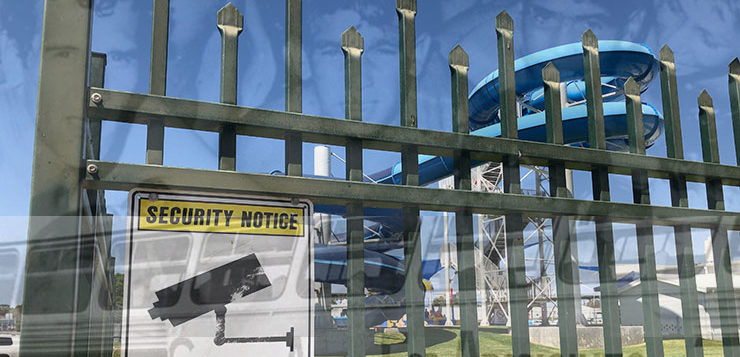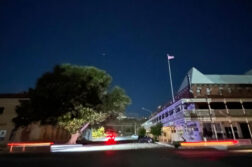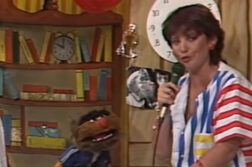In the third in his series ‘The Fantastical Historical Political Outback Tour – Aboriginal Edition’ New Matilda editor Chris Graham visits Moree, a cattle and cotton farming town in the north west of NSW. It’s a community renowned for its shocking history of racism. But enough about that, have you seen their new fun park?
The local swimming pool at Moree has come a long way from the heady days of officially gazetted Australian Apartheid.
That’s right, I said it. Apartheid. The other ‘A’ word. The devil is in the detail, which I’ll get to shortly, but first the brief history.
Most people associate the policy with white South Africa, but in fact Apartheid had been in place in Australia for decades before it was officially co-opted then adopted by the Afrikaners in 1948.
By 1963, alarm was growing around the globe at South Africa’s brutal oppression of ‘blacks and coloureds’. The United Nations met and passed a resolution condemning the policy, and 96 nations voted in favour of it. Unsurprisingly, Australia – the original architect of Apartheid – along with Belgium, Canada, France, Netherlands, New Zealand, Panama, the United Kingdom and the United States, abstained from voting.
Even so, United Nations Resolution 1761 sent shockwaves around the world, and was the start of the boycott movement against South Africa which eventually brought down the Apartheid regime (Israel, Eurovision and SBS television… take note).
Today, South Africa acknowledges its dark past in its Constitution, and with institutions such as the Apartheid Museum in Johannesburg. The entrance has two doors – one for whites, one for non-whites.
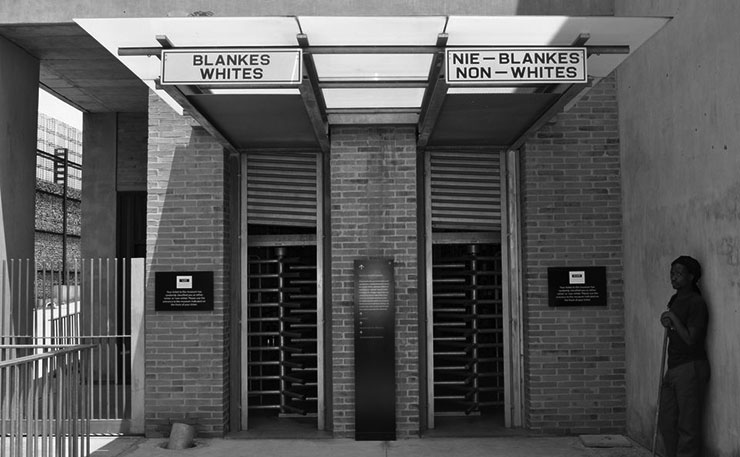
So how does all this relate to Moree?
In 1955, the Moree Shire Council passed a by-law which banned Aboriginal people from the swimming pool. In case you missed it, the word by-law has the word ‘law’ in it, precisely because it is a law. In other words, official government policy. Apartheid.
A decade later, spurred on by the civil rights movement in the US, and less than 18 months after the UN resolution, a group of students from the University of Sydney led by Arrernte man Charles Perkins, decided to head out bush and confront Australian Apartheid head on.
Perkins and his mob – which numbered almost two dozen – headed north on a bus to confront the good people of Moree (and Walgett, Gulargambone, Bowraville, Kempsey and others). They arrived in Moree on February 19, exactly 54 years ago this week.
What followed is now the stuff of legend. A showdown at the Moree Baths saw local council officials, police and residents scuffle with Perkins and the protestors, who were trying to escort a group of young Aboriginal children into the pool. The story reverberated around a shocked nation, and then the world.
Of course, Apartheid in Moree wasn’t just limited to the pool – Aboriginal people were actively prevented from participating in all parts of civil life by white authorities. They were even excluded in death, with the Moree cemetery officially segregated.
Soon after the Freedom Riders left Moree, a shamed and chastened Moree Council rescinded the 1955 by-law. Life in Moree ever since has been a model of racial harmony. Said no person ever.
Today, the Moree baths – the site of one of Australia’s most infamous Apartheid showdowns – looks like a fun park, with a day spa, a gym, an indoor pool and a huge water slide that, from the newly built highway bypass, dominates the Moree township landscape.
It’s the sort of ‘sensitive tourism strategy’ not all that far removed from the one exposed in John Pilger’s film Utopia* about Rottnest Island in Western Australia, once a concentration camp that oversaw the deaths of hundreds of Aboriginal people, but which today is a tourist playground where, for the right price, you can stay overnight in one of the prisons cells.
The fascia of the Moree baths has changed, and so has the name. It’s now called the Moree Artesian Aquatic Centre, after a move almost a decade ago some suggested was designed to scrub off the stain of world-class racism.
Point being, the Moree Baths look very different today. I’m not entirely convinced you can say that about the town proper.
Modern Moree
Moree is undeniably less overtly racist today than it was in 1965. And the Aboriginal population of Moree has undeniably progressed. There is an emerging Aboriginal middle class in the town, albeit small compared to the white population. There are also many white people in town who have worked hard to mend relations. But many Aboriginal locals claim – and some whites will admit – that the town still has a major problem with racism.
The proof for that is in the life statistics of the Aboriginal community, which lag a very long way behind the sort of progress we’ve seen at the Moree Artesian Aquatic Centre.
Accessing Aboriginal-specific data is never simple, or at least it never used to be. But in this case, the NSW Department of Aboriginal Affairs has compiled a very helpful (and very comprehensive) data sheet which outlines some of the major areas of importance. It makes for very sobering reading, unless you live in Moree. In which case, it makes for the sort of reading that might turn you to the drink.
The median income of Aboriginal people in 2016 was just $377 a week. That compares to a town average of $756. In other words, it’s just under half.
On household income, Aboriginal homes fare slightly better comparatively, although that’s entirely thanks to the fact Aboriginal households are larger, because they’re poorer. It was $854 per week in 2016, compared to $1,355 per week for whites. That’s a gap of 37 per cent.
Home ownership is a train wreck. About one-quarter of Aboriginal households in Moree own (or are paying off) their own home, although the rate since 2006 has only improved by 2 per cent. Admittedly, that’s much better than it was in 1965, when the notion of ‘a black’ owning a home in Moree was unthinkable. But still, the rate of home ownership for non-Aboriginal people is 61 per cent – almost three times greater.
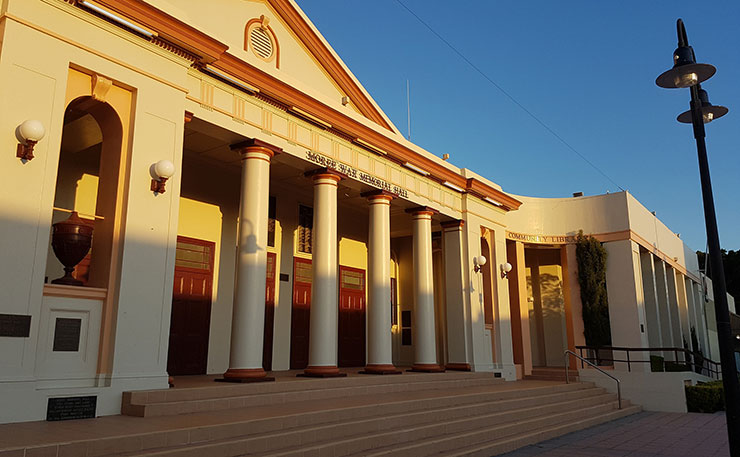
In education, less than half the Aboriginal population aged 15-19 remains in education (49 per cent). That compares to 69 per cent among whites.
The year 12 completion rate for Aboriginal teens is 19 per cent and less than half the white rate (43 per cent). Can you imagine the outcome in broader non-Aboriginal Australia if the completion rate of high school was less than one in five people?
One of the only figures in the DAA fact sheet in which Aboriginal people beat non-Aboriginal people is in those with a severe, long-term disability – 5.9 per cent compared to 4.3 per cent.
Put simply, non-Aboriginal people in Moree on average live at least twice as well as Aboriginal people.
It’s worth noting that all these statistics are predicated on an Australian Bureau of Statistics (ABS) census that acknowledges a 17.5 per cent undercount of Aboriginal people nationally. (I call those folk the ‘invisible Aboriginals’. Can you imagine the outcome if the ABS somehow managed to miss counting almost one in five non-Aboriginal Australians? Our population would increase by 4.2 million people overnight… which leaves much less money for electoral pork-barrelling!)?
Stain removal
And so how does all this relate to the local pool? Like I mentioned earlier, Moree has tried over the years to scrub the racist stain from its past. But like many towns in Australia, Moree’s changes to its Apartheid regime remain, at least in part, cosmetic.
Remarkably, a town with a 20 per cent Indigenous population has no Aboriginal representation on the local council. There also appears to be no Aboriginal people on the Board of Directors of the newly formed Moree Artesian Aquatic Centre Ltd, a company founded by the local council to manage the major upgrade to the pool. And this is where things get interesting, and awkward. Calls to Moree Plains Shire Council for an explanation were ignored.
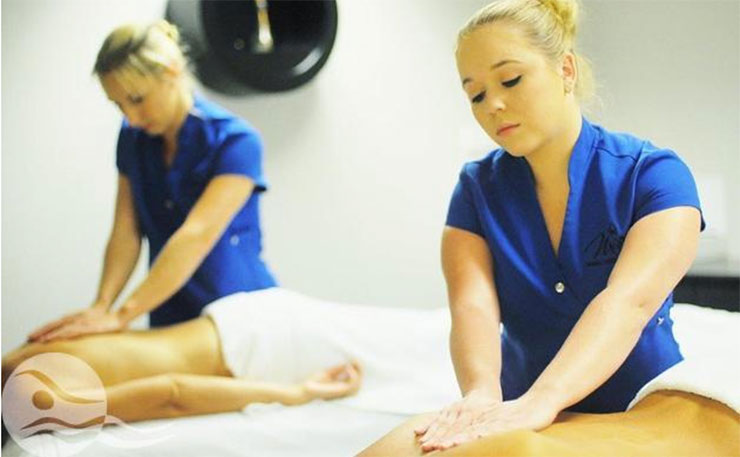
In announcing action against the company that performed the renovation (and apparently botched it), Mayor Katrina Humphries made clear what the upgrade was intended to achieve.
“As owner of this community asset, Council is pursuing these proceedings to ensure the facility can realise its full potential as a major tourist attraction for the region,” Cr Humphries said.
“Given Moree is known as Australia’s ‘artesian water country’ it’s vital we make the most of this facility.”
Well… that’s ONE thing Australia knows Moree for. The other, obviously, is racism. Admittedly, Moree Plains Shire Council acknowledge that, with a small plaque in the corner at the front of the building. But as for the rest of the complex, as I mentioned above, the Baths are now just a big old water world-style fun park, which is even more curious when you consider that the pool’s reputation as a pillar of Apartheid has been officially recognised, in perpetuity, at the highest levels of government.
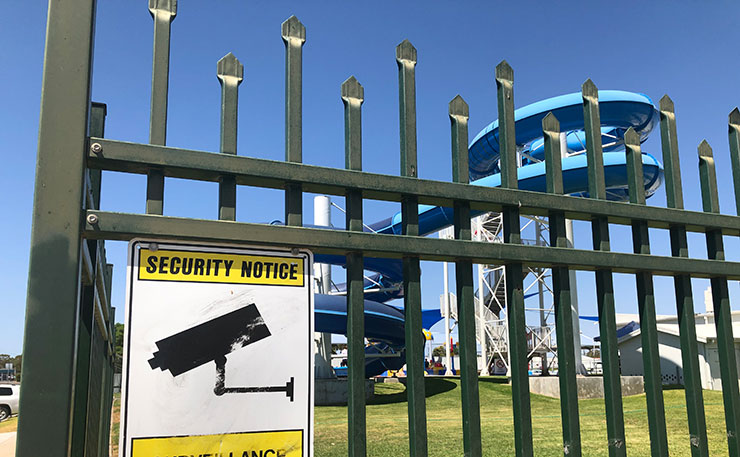
In 2013, in a rare and frankly surprising development, the federal Department of Environment listed the Moree Baths on the National Heritage Register… specifically for its history of apartheid. They just didn’t use the ‘A’ word’.
The official blurb opens with this line: “During the 1965 Freedom Ride through outback New South Wales, a stark example of official segregation was encountered in the exclusion of Aboriginal people from the swimming pool. The protests brought racial discrimination to the attention and consciousness of the wider community and forced non-Aboriginal Australians to examine their attitudes to Aboriginal Australians.”
Although the federal government has delivered a sanitised version of history – ‘Official segregation’ is just a mealy-mouthed way of saying Apartheid – it should still be acknowledged that the Moree Baths got National Heritage status at all.
But should a site that occupies such an important corner of the nation’s psyche – whether we like to honestly acknowledge that psyche or not – be converted to something that resembles a theme park?
Contrast Australia’s recognition of its black past with the way South Africa has done it. Or as a close friend recently remarked to me, would you be happy if the Australian War Memorial added a water slide and day spa, plus hats and t-shirts and tourist trinkets, then renamed itself ‘Anzac World’?
As for Moree itself, it can head to the Baths and scrub as hard as it likes, but with a National Heritage Listing and a local Aboriginal population that well remembers the days of official Apartheid, and continues to live through the days of unofficial Apartheid, that stain ain’t coming off any time soon.
By way of postscript, and a plug for the next article in this series, I mentioned at the start of this story that Moree was “infamous” for its role in the 1965 Freedom Rides. My next story in the ‘New Matilda Fantastical Historical Political Outback Tour – Aboriginal Tour’ is from Walgett, a town included in the Freedom Rides but which got substantially less publicity than Moree. It most definitely shouldn’t have. That yarn is coming soon.
CORRECTION: An earlier version of this story incorrectly reported Katrina Humphries is the wife of former Water Minister Kevin Humphries. Stupid error. Apologies to Ms Humphries.
* Chris Graham acted as the Associate Producer on John Pilger’s film Utopia.
Donate To New Matilda
New Matilda is a small, independent media outlet. We survive through reader contributions, and never losing a lawsuit. If you got something from this article, giving something back helps us to continue speaking truth to power. Every little bit counts.

